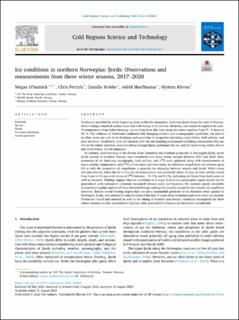| dc.contributor.author | O'Sadnick, Megan | |
| dc.contributor.author | Petrich, Chris | |
| dc.contributor.author | Brekke, Camilla | |
| dc.contributor.author | Skardhamar, Jofrid | |
| dc.contributor.author | Kleven, Øystein | |
| dc.date.accessioned | 2022-09-28T11:16:24Z | |
| dc.date.available | 2022-09-28T11:16:24Z | |
| dc.date.created | 2022-09-06T10:01:58Z | |
| dc.date.issued | 2022 | |
| dc.identifier.citation | Cold Regions Science and Technology. 2022, . | |
| dc.identifier.issn | 0165-232X | |
| dc.identifier.uri | https://hdl.handle.net/11250/3022140 | |
| dc.description.abstract | Freshwater provided by rivers beginning deep within the mountains, feeds into fjords along the coast of Norway, often forming a brackish surface layer that will change in its salinity, thickness, and extent throughout the year. As temperature drops below freezing, ice can form from this layer along the entire coastline from 71° N down to 58° N. The influence of freshwater combined with changing weather and oceanographic conditions, can lead to ice that varies not only in its thickness and extent but its properties including crystal fabric, bulk salinity, and pore structure. Resultantly, how ice interacts with the surrounding environment including communities that use the ice for winter activities, boats transiting through fjords, pollutants like oil, and the biota living within the ice and fjord waters, will be impacted. To enhance understanding of the drivers of ice formation and resultant properties in Norwegian fjords, seven fjords located in northern Norway were monitored over three winter seasons between 2017 and 2020. Measurements of ice thickness, stratigraphy, bulk salinity, and δ18O were gathered along with measurements of ocean salinity, temperature, and δ18O of both snow and river water. Ice thickness ranged from non-existent up to 0.8 m with the proportion of congelation to granular ice changing between seasons and fjords. While ocean salinities directly below the ice on the day of measurement were primarily above 31 psu, ice bulk salinity varied from 0 psu to 5.6 psu with values of δ18O between - 13.3 ‰ and 0.2 ‰, indicating ice frozen from fresh water as well as seawater. Findings support that ice conditions in a single fjord or in a geographic region should not be generalized, with substantial variations measured between years and locations. We examine openly accessible interpolated weather and runoff data obtained through seNorge for possible causes for the variable ice conditions observed. Results reveal freezing degree days are not a dependable predictor of ice thickness when applied to Norwegian fjords, and substantial consideration of the date of onset of ice formation and snow cover are needed. Freshwater runoff and snowfall as well as the timing of weather and oceanic conditions throughout the three winter seasons are also presented to highlight their potential to influence ice formation considerably. | |
| dc.description.abstract | Ice conditions in northern Norwegian fjords: Observations and measurements from three winter seasons, 2017–2020 | |
| dc.language.iso | eng | |
| dc.subject | Ice-ocean interaction | |
| dc.subject | Ice-ocean interaction | |
| dc.subject | Coastal processes | |
| dc.subject | Coastal processes | |
| dc.subject | Sea ice | |
| dc.subject | Sea ice | |
| dc.title | Ice conditions in northern Norwegian fjords: Observations and measurements from three winter seasons, 2017–2020 | |
| dc.title.alternative | Ice conditions in northern Norwegian fjords: Observations and measurements from three winter seasons, 2017–2020 | |
| dc.type | Peer reviewed | |
| dc.type | Journal article | |
| dc.description.version | publishedVersion | |
| dc.subject.nsi | VDP::Annen marin teknologi: 589 | |
| dc.subject.nsi | VDP::Other marine technology: 589 | |
| dc.source.pagenumber | 20 | |
| dc.source.journal | Cold Regions Science and Technology | |
| dc.identifier.doi | 10.1016/j.coldregions.2022.103663 | |
| dc.identifier.cristin | 2049105 | |
| dc.relation.project | Norges forskningsråd: 237906 | |
| cristin.ispublished | true | |
| cristin.fulltext | original | |
| cristin.qualitycode | 2 | |
